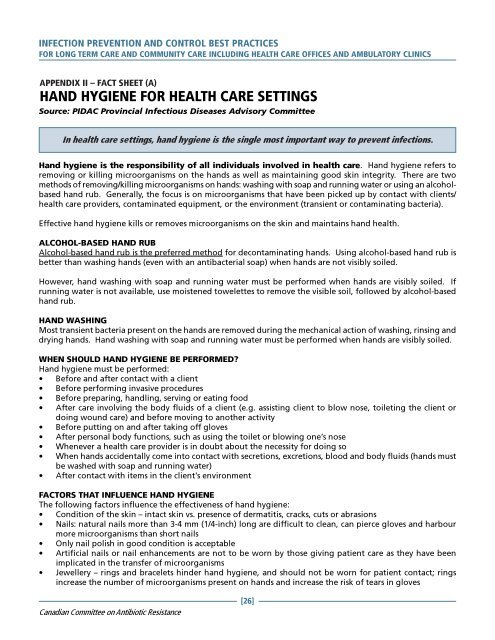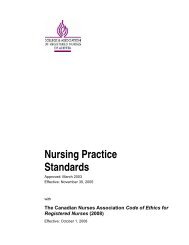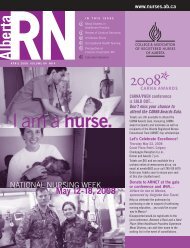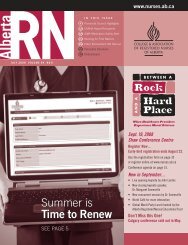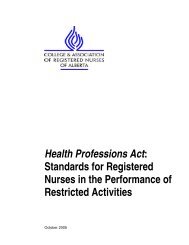Infection Prevention and Control Best Practices - College ...
Infection Prevention and Control Best Practices - College ...
Infection Prevention and Control Best Practices - College ...
Create successful ePaper yourself
Turn your PDF publications into a flip-book with our unique Google optimized e-Paper software.
INFECTION PREVENTION AND CONTROL BEST PRACTICES<br />
FOR LONG TERM CARE AND COMMUNITY CARE INCLUDING HEALTH CARE OFFICES AND AMBULATORY CLINICS<br />
APPENDIX II – FACT SHEET (A)<br />
HAND HYGIENE FOR HEALTH CARE SETTINGS<br />
Source: PIDAC Provincial Infectious Diseases Advisory Committee<br />
In health care settings, h<strong>and</strong> hygiene is the single most important way to prevent infections.<br />
H<strong>and</strong> hygiene is the responsibility of all individuals involved in health care. H<strong>and</strong> hygiene refers to<br />
removing or killing microorganisms on the h<strong>and</strong>s as well as maintaining good skin integrity. There are two<br />
methods of BEFORE... removing/killing microorganisms on AFTER...<br />
h<strong>and</strong>s: washing with soap <strong>and</strong> running water or using an alcoholbased<br />
h<strong>and</strong> rub. Generally, the focus is on microorganisms that have been picked up by contact with clients/<br />
health care providers, contaminated equipment, or the environment (transient or contaminating bacteria).<br />
Effective h<strong>and</strong> hygiene kills or removes microorganisms on the skin <strong>and</strong> maintains h<strong>and</strong> health.<br />
ALCOHOL-BASED HAND RUB<br />
Alcohol-based h<strong>and</strong> rub is the preferred method for decontaminating h<strong>and</strong>s. Using alcohol-based h<strong>and</strong> rub is<br />
better than washing h<strong>and</strong>s (even with an antibacterial soap) when h<strong>and</strong>s are not visibly soiled.<br />
However, h<strong>and</strong> washing with soap <strong>and</strong> running water must be performed when h<strong>and</strong>s are visibly soiled. If<br />
running water is not available, use moistened towelettes to remove the visible soil, followed by alcohol-based<br />
h<strong>and</strong> rub.<br />
HAND WASHING<br />
Most transient bacteria present on the h<strong>and</strong>s are removed during the mechanical action of washing, rinsing <strong>and</strong><br />
drying h<strong>and</strong>s. H<strong>and</strong> washing with soap <strong>and</strong> running water must be performed when h<strong>and</strong>s are visibly soiled.<br />
WHEN SHOULD HAND HYGIENE BE PERFORMED?<br />
H<strong>and</strong> hygiene must be performed:<br />
• Before <strong>and</strong> after contact with a client<br />
• Before performing invasive procedures<br />
• Before preparing, h<strong>and</strong>ling, serving or eating food<br />
• After care involving the body fluids of a client (e.g. assisting client to blow nose, toileting the client or<br />
doing wound care) <strong>and</strong> before moving to another activity<br />
• Before putting on <strong>and</strong> after taking off gloves<br />
• After personal body functions, such as using the toilet or blowing one’s nose<br />
• Whenever a health care provider is in doubt about the necessity for doing so<br />
• When h<strong>and</strong>s accidentally come into contact with secretions, excretions, blood <strong>and</strong> body fluids (h<strong>and</strong>s must<br />
be washed with soap <strong>and</strong> running water)<br />
• After contact with items in the client’s environment<br />
FACTORS THAT INFLUENCE HAND HYGIENE<br />
The following factors influence the effectiveness of h<strong>and</strong> hygiene:<br />
• Condition of the skin – intact skin vs. presence of dermatitis, cracks, cuts or abrasions<br />
• Nails: natural nails more than 3-4 mm (1/4-inch) long are difficult to clean, can pierce gloves <strong>and</strong> harbour<br />
more microorganisms than short nails<br />
• Only nail polish in good condition is acceptable<br />
• Artificial nails or nail enhancements are not to be worn by those giving patient care as they have been<br />
implicated in the transfer of microorganisms<br />
• Jewellery – rings <strong>and</strong> bracelets hinder h<strong>and</strong> hygiene, <strong>and</strong> should not be worn for patient contact; rings<br />
increase the number of microorganisms present on h<strong>and</strong>s <strong>and</strong> increase the risk of tears in gloves<br />
Canadian Committee on Antibiotic Resistance<br />
[26]


